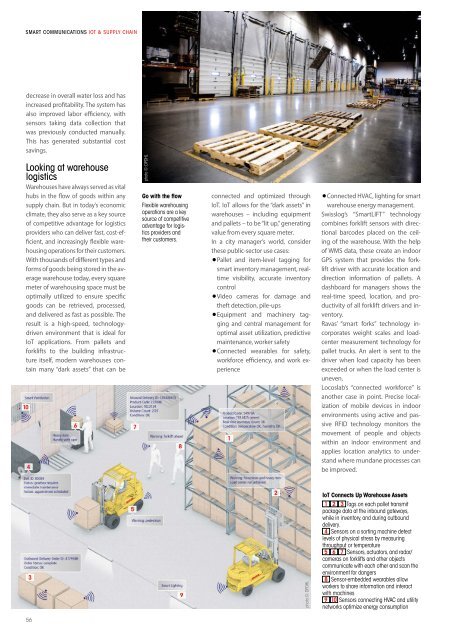Smart Industry 2/2018
Smart Industry 2/2018 - The IoT Business Magazine - powered by Avnet Silica
Smart Industry 2/2018 - The IoT Business Magazine - powered by Avnet Silica
You also want an ePaper? Increase the reach of your titles
YUMPU automatically turns print PDFs into web optimized ePapers that Google loves.
<strong>Smart</strong> Communications IoT & Supply Chain<br />
decrease in overall water loss and has<br />
increased profitability. The system has<br />
also improved labor efficiency, with<br />
sensors taking data collection that<br />
was previously conducted manually.<br />
This has generated substantial cost<br />
savings.<br />
Looking at warehouse<br />
logistics<br />
Warehouses have always served as vital<br />
hubs in the flow of goods within any<br />
supply chain. But in today’s economic<br />
climate, they also serve as a key source<br />
of competitive advantage for logistics<br />
providers who can deliver fast, cost-efficient,<br />
and increasingly flexible warehousing<br />
operations for their customers.<br />
With thousands of different types and<br />
forms of goods being stored in the average<br />
warehouse today, every square<br />
meter of warehousing space must be<br />
optimally utilized to ensure specific<br />
goods can be retrieved, processed,<br />
and delivered as fast as possible. The<br />
result is a high-speed, technologydriven<br />
environment that is ideal for<br />
IoT applications. From pallets and<br />
forklifts to the building infrastructure<br />
itself, modern warehouses contain<br />
many “dark assets” that can be<br />
10<br />
4<br />
6 7<br />
photo ©: DPDHL<br />
Go with the flow<br />
Flexible warehousing<br />
operations are a key<br />
source of competitive<br />
advantage for logistics<br />
providers and<br />
their customers.<br />
8<br />
connected and optimized through<br />
IoT. IoT allows for the “dark assets” in<br />
warehouses – including equipment<br />
and pallets – to be “lit up,” generating<br />
value from every square meter.<br />
In a city manager’s world, consider<br />
these public-sector use cases:<br />
• Pallet and item-level tagging for<br />
smart inventory management, realtime<br />
visibility, accurate inventory<br />
control<br />
• Video cameras for damage and<br />
theft detection, pile-ups<br />
• Equipment and machinery tagging<br />
and central management for<br />
optimal asset utilization, predictive<br />
maintenance, worker safety<br />
• Connected wearables for safety,<br />
workforce efficiency, and work experience<br />
1<br />
• Connected HVAC, lighting for smart<br />
warehouse energy management.<br />
Swisslog’s “<strong>Smart</strong>LIFT” technology<br />
combines forklift sensors with directional<br />
barcodes placed on the ceiling<br />
of the warehouse. With the help<br />
of WMS data, these create an indoor<br />
GPS system that provides the forklift<br />
driver with accurate location and<br />
direction information of pallets. A<br />
dashboard for managers shows the<br />
real-time speed, location, and productivity<br />
of all forklift drivers and inventory.<br />
Ravas’ “smart forks” technology incorporates<br />
weight scales and loadcenter<br />
measurement technology for<br />
pallet trucks. An alert is sent to the<br />
driver when load capacity has been<br />
exceeded or when the load center is<br />
uneven.<br />
Locoslab’s “connected workforce” is<br />
another case in point. Precise localization<br />
of mobile devices in indoor<br />
environments using active and passive<br />
RFID technology monitors the<br />
movement of people and objects<br />
within an indoor environment and<br />
applies location analytics to understand<br />
where mundane processes can<br />
be improved.<br />
3<br />
5<br />
9<br />
2<br />
photo ©: DPDHL<br />
IoT Connects Up Warehouse Assets<br />
1 2 3 Tags on each pallet transmit<br />
package data at the inbound gateways,<br />
while in inventory, and during outbound<br />
delivery.<br />
4 Sensors on a sorting machine detect<br />
levels of physical stress by measuring<br />
throughput or temperature<br />
5 6 7 Sensors, actuators, and radar/<br />
cameras on forklifts and other objects<br />
communicate with each other and scan the<br />
environment for dangers<br />
8 Sensor-embedded wearables allow<br />
workers to share information and interact<br />
with machines<br />
9 10 Sensors connecting HVAC and utility<br />
networks optimize energy consumption<br />
56
















